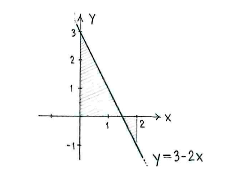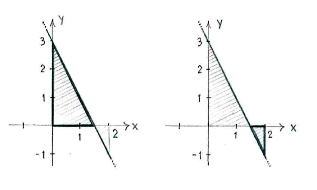Lösung 2.1:1c
Aus Online Mathematik Brückenkurs 2
(Unterschied zwischen Versionen)
| (Der Versionsvergleich bezieht 6 dazwischen liegende Versionen mit ein.) | |||
| Zeile 1: | Zeile 1: | ||
| - | + | Die Gerade <math>y=3-2x</math> schneidet die ''x''-Achse im Punkt | |
| - | <math>y=3-2x</math> | + | |
| - | + | ||
| - | + | ||
| - | - | + | |
| + | {{Abgesetzte Formel||<math>y=3-2x=0\quad \Leftrightarrow \quad x=3/2.</math>}} | ||
| - | <math> | + | Also liegt ein Teil der Geraden <math>x=3/2</math> unter der ''y''-Achse. |
| - | + | ||
| - | + | ||
| - | + | ||
| - | + | ||
| - | + | ||
| - | + | ||
| - | - | + | |
| - | + | ||
[[Image:2_1_1_c1.gif|center]] | [[Image:2_1_1_c1.gif|center]] | ||
| - | + | Wenn wir das Integral berechen, müssen wir berücksichtigen, dass die Fläche, die unter der ''y''-Achse liegt, von der Fläche oberhalb der ''y''-Achse subtrahiert werden muss. | |
| - | + | ||
| - | + | ||
| - | + | ||
| - | - | + | |
| - | + | ||
| - | - | + | |
| - | + | ||
| - | + | ||
| - | + | ||
| - | + | ||
| - | + | ||
| - | + | ||
| + | Wir teilen unsere Fläche also in eine linke und eine rechte Fläche auf | ||
[[Image:2_1_1_c2.gif|center]] | [[Image:2_1_1_c2.gif|center]] | ||
| - | + | und erhalten | |
| - | + | ||
| - | <math>\int\limits_{0}^{2} | + | {{Abgesetzte Formel||<math>\int\limits_{0}^{2} (3-2x)\,dx = \frac{1}{2}\cdot\frac{3}{2}\cdot 3 - \frac{1}{2}\cdot\frac{1}{2}\cdot 1 = \frac{9}{4} - \frac{1}{4} = 2\,\textrm{.}</math>}} |
Aktuelle Version
Die Gerade \displaystyle y=3-2x schneidet die x-Achse im Punkt
| \displaystyle y=3-2x=0\quad \Leftrightarrow \quad x=3/2. |
Also liegt ein Teil der Geraden \displaystyle x=3/2 unter der y-Achse.
Wenn wir das Integral berechen, müssen wir berücksichtigen, dass die Fläche, die unter der y-Achse liegt, von der Fläche oberhalb der y-Achse subtrahiert werden muss.
Wir teilen unsere Fläche also in eine linke und eine rechte Fläche auf
und erhalten
| \displaystyle \int\limits_{0}^{2} (3-2x)\,dx = \frac{1}{2}\cdot\frac{3}{2}\cdot 3 - \frac{1}{2}\cdot\frac{1}{2}\cdot 1 = \frac{9}{4} - \frac{1}{4} = 2\,\textrm{.} |


